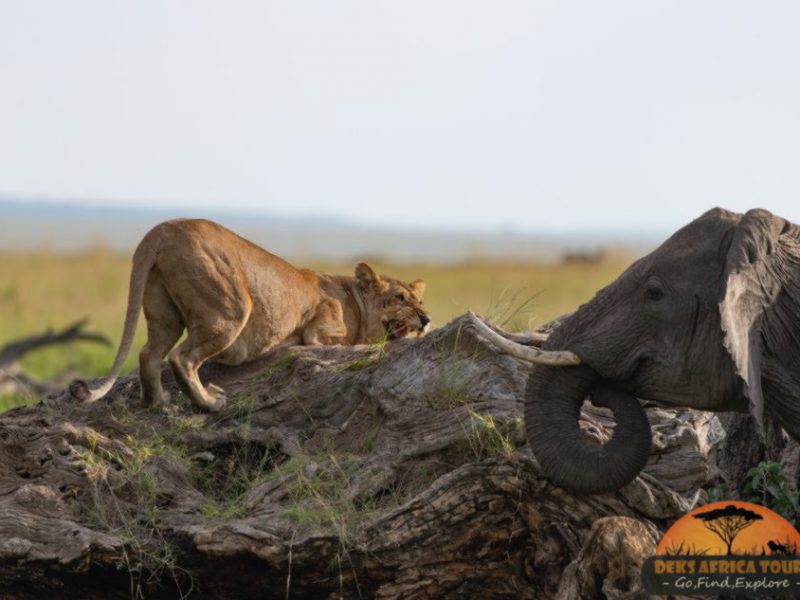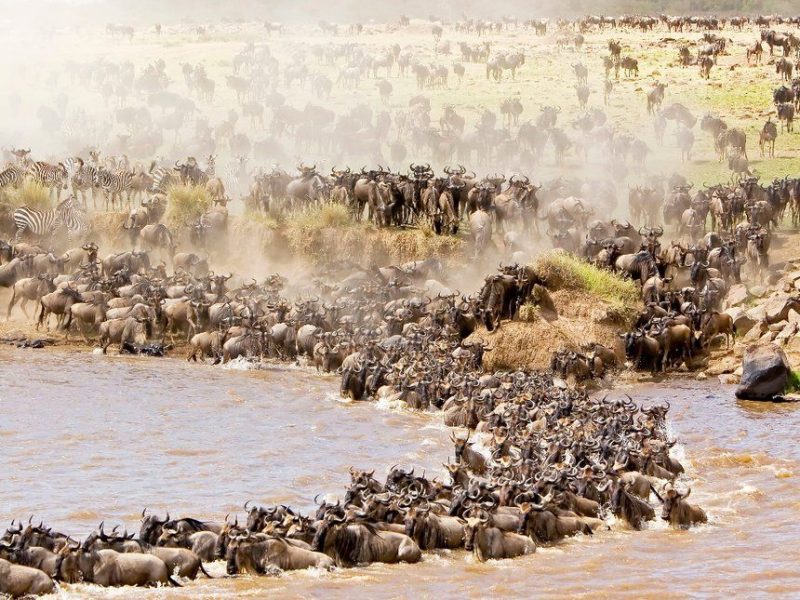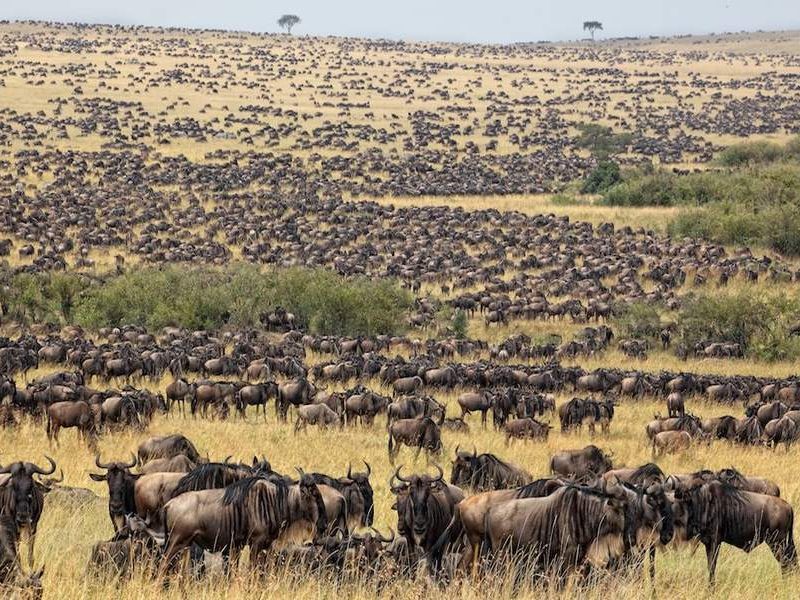Captivating Facts About the Great Wildlife Migration in Tanzania – Serengeti National Park
Embark on an immersive Tanzanian safari, delving into the real-life drama of the Great Wildlife Migration in Tanzania! As you venture through the expansive Serengeti National Park from July to October, your knowledgeable guide, immersed in the African paradise, eagerly directs your attention to a distant dust cloud billowing on the horizon. Your eyes remain fixed, anticipation building for the magnificent scenes that await during Tanzania’s extraordinary great wildlife migration. Approaching the source of the aerial disturbance in your safari vehicle, you sense a subtle trembling beneath your feet.
Suddenly, colossal silhouettes of wildebeests materialize from the dust—a tumultuous amalgamation of hooves, gray-black fur, white beards, tails, and short manes thundering across the plains. Passing by the herd, flashes of black and white reveal the presence of zebras. Following their path, you witness an unending multitude of these creatures grazing amid shades of emerald-green grass. Your guide cautiously approaches the animals, and just beyond a hill crest, a distinctive landmark comes into view—the Mara River.
Guiding you to an exceptional vantage point near the Mara River, your guide heightens the palpable energy in the air. Dozens of wildebeests stand along a ledge just above the river, stomping and grunting in anticipation. Observing their hesitation, you shift your gaze to the river itself—a massive volume of water rushing past, posing a treacherous challenge for even the strongest wildebeests. Stealthy predators, ferocious crocodiles lurk in the water, anticipating the impending rush of prey.
Ultimate Tanzania Safaris Combined With The Great Wildlife Migrations in Serengeti National Park
3 Days Tanzania safaris Tour Holiday
This 3 Days Tanzania safari Ngorongoro Crater conservation area and Lake Mara national park Africa Tour will give you an opportunity to explore the amazing.
5 Days Best of Tanzania Adventure safari
This 5 Days Best of Tanzania Adventure safari pack is meant to indulge travelers and offer an exclusive lifetime adventure in Tanzania’s diverse wildlife. On this…
7 Days Adventure Tanzania Wildlife Safari
This 7 Days Wildlife Exclusive Adventure Tanzania Safari, Great Wildlife Migration Tanzania, Tanzania Wildlife Adventure Safari is a well-customized safari package.
Great Wildlife Migration in Tanzania
Tanzania is home to one of the most spectacular wildlife migrations in the world—the Great Wildlife Migration. This annual event involves the movement of millions of wildebeest, zebras, and other herbivores across the Serengeti ecosystem in Tanzania and the Maasai Mara ecosystem in Kenya. The migration is driven by the search for fresh grazing pastures and water sources.
To witness the Great Wildlife Migration in Tanzania, it is advisable to plan a safari during the appropriate months, keeping in mind the movement patterns of the herds. Different regions of the Serengeti offer different experiences at various times of the year, so consulting with experienced safari operators can help plan the best itinerary for a memorable wildlife experience.
As the restlessness among the wildebeests intensifies, you sense that the pivotal moment is approaching. Without warning, the first individual stumbles down the ledge, its body twisting and contorting. With a final desperate jump, it lands in the muddy waters of the Mara River. Panic-stricken, its eyes wide, the solo journey begins. Thousands more wildebeests follow, transforming the swirling river into a chaotic frenzy of splashing water, drowning calves, and the relentless struggle between prey and predators like crocodiles.
The Key Highlights of the Great Wildlife or Wildebeest Migration in Tanzania include
The river becomes strewn with carcasses, remnants of those too weak or slow to make the crossing, while gigantic vultures gather at the banks to feast. Yet, joy fills your heart as you witness a mother assisting her exhausted calf in climbing the slippery slope on the other side of the river. Swiftly as the crossing began, the wildebeest herd vanishes into the distance, continuing their perpetual journey to Tanzania’s richest grazing grounds.
- Circular Route
- Calving Season
- River Crossings
- Predator Interaction
- Hot Air Balloon Safaris
- Conservation Challenges
About Circular Route in Great Wildlife Migration in Tanzania
The Circular Route of the Great Wildlife Migration in Tanzania is a fascinating and dynamic journey undertaken by millions of wildebeests, zebras, and other herbivores across the Serengeti ecosystem in Tanzania and the Maasai Mara ecosystem in Kenya. This remarkable natural phenomenon unfolds in a cyclical pattern, creating a perpetual spectacle that captivates wildlife enthusiasts and conservationists alike.
Spanning a significant portion of the year, the migration typically follows a clockwise trajectory through the Serengeti National Park in Tanzania. The timing and exact route can vary based on factors such as rainfall and the availability of fresh grazing pastures. The migration is a constant quest for sustenance, with the herbivores in search of greener grasslands and water sources.
One notable phase of the Circular Route is the calving season, which occurs around January to February in the southern Serengeti. During this period, the wildebeests give birth to their young, attracting predators and adding a dramatic layer to the migration. The vulnerable newborns face a perilous journey from the moment they take their first steps.
River crossings Experience
River crossings are another highlight of the Circular Route, especially at locations like the Grumeti and Mara rivers. The wildebeests and zebras must navigate these rivers, braving crocodile-infested waters and strong currents. These crossings are both a spectacle and a survival challenge, as predators await the opportunity to seize their prey.
Throughout the Circular Route, predators such as lions, cheetahs, and hyenas play a crucial role in the ecosystem by hunting and maintaining a balance in the wildlife population. The migration, therefore, is not only a mass movement of herbivores but also a dynamic interplay between prey and predators.
The Circular Route of the Great Wildlife Migration is a testament to the resilience and adaptability of nature, showcasing the intricate connections between animals and their environment. Conservation efforts are vital to preserving this awe-inspiring phenomenon, ensuring the continued existence of one of the most remarkable wildlife migrations on the planet. Visitors planning to witness this spectacle should consider the seasonal variations and consult with experienced guides and safari operators to optimize their wildlife viewing experience.
Calving Season During Great Wildlife Migration of Tanzania
The calving season is a pivotal and dramatic phase within the Great Wildlife Migration in Tanzania. It occurs annually, generally from January to February, in the southern reaches of the Serengeti National Park. This period is characterized by the mass birthing of wildebeest calves, zebras, and other herbivores, adding an extra layer of intensity and vulnerability to the already spectacular migration.
During the calving season, the female wildebeests give birth to their young, a synchronized event that sees thousands of newborns taking their first steps on the Serengeti plains. The timing of the calving season is often influenced by the availability of fresh grass, triggered by the region’s seasonal rainfall patterns. This abundance of nutrient-rich vegetation is crucial for the nursing mothers and their offspring.
The calving season is not only a time of renewal but also a time of increased predation. The vulnerable newborns become easy targets for predators such as lions, cheetahs, and hyenas. The predators take advantage of the abundance of young and inexperienced prey, creating a challenging environment for the wildebeest mothers and their calves.
Conservation efforts play a crucial role in ensuring the survival of the wildebeest population and maintaining the ecological balance of the Serengeti ecosystem. Understanding and appreciating the significance of the calving season contributes to the broader awareness of the challenges faced by these remarkable animals during their epic journey across the Tanzanian landscape.
River Crossings on great wildlife migration in Serengeti
The river crossings are among the most thrilling and visually captivating aspects of the Great Wildlife Migration in the Serengeti. This natural spectacle occurs as millions of wildebeests, zebras, and other herbivores traverse various rivers in their quest for greener pastures. The crossings are both a perilous and mesmerizing event, showcasing the determination and survival instincts of the migrating animals.
The wildebeest calves are born with an instinct to stand and walk shortly after birth, allowing them to keep up with the herd during the migration. However, this period is fraught with dangers, and many young calves fall victim to predators or face challenges during river crossings.
For wildlife enthusiasts and safari-goers, the calving season offers a unique and emotionally charged experience. Witnessing the delicate balance between life and death, survival and predation, adds a profound dimension to the overall understanding of the intricate dynamics of the Great Wildlife Migration.
Key features of river crossings during the Great Wildlife Migration in the Serengeti include:
Strategic Locations
River crossings commonly take place at strategic locations, with the Grumeti and Mara rivers being particularly noteworthy. These water obstacles present a significant challenge for the migrating herds, as they must navigate swift currents and contend with the presence of predators, particularly crocodiles.
Dramatic Scenes
The sight of thousands of wildebeests and zebras congregating on the riverbanks, their collective restlessness palpable, creates a dramatic prelude to the actual crossing. Dust clouds often hover in the air as the animals prepare for the aquatic challenge.
Hesitation and Tension
The moments leading up to a river crossing are filled with hesitation and tension. The herds gather along the riverbanks, their instincts seemingly in conflict with the formidable obstacle before them. Predators, too, may linger in anticipation, adding to the suspense.
Risks and Dangers
The rivers pose numerous risks to the migrating animals. Swift currents can sweep them away, and lurking beneath the surface are the ever-present threats of crocodiles. Many animals do not make it across successfully, succumbing to exhaustion, drowning, or falling prey to predators.
Survival of the Fittest
River crossings are a powerful illustration of the principle of survival of the fittest. Only the strongest and most agile individuals successfully navigate the challenging waters, reaching the opposite bank to continue their journey.
Impacts on Ecosystem
The river crossings have broader ecological implications, affecting the population dynamics of both prey and predator species. The nutrient-rich waters of the rivers support diverse wildlife, and the carcasses of those that do not survive contribute to the ecosystem’s overall health.
Visitors to the Serengeti during the Great Wildlife Migration season often plan their safaris to coincide with potential river crossings. Experienced guides and safari operators play a crucial role in maximizing the chances of witnessing this awe-inspiring spectacle while respecting the need for conservation and responsible tourism practices.
Predator Interaction in Mara River
Predator interaction is a captivating and integral aspect of the Great Wildlife Migration in the Serengeti. As millions of herbivores, primarily wildebeests and zebras, journey across the landscape in search of food and water, they become part of a dynamic ecosystem where predators play a crucial role in maintaining balance.
Observing predator interaction during the Great Wildlife Migration is a thrilling experience for safari-goers. Knowledgeable guides and wildlife experts often provide valuable insights into the behavior of both predators and prey, enhancing the understanding of the complex dynamics that unfold during this remarkable natural phenomenon. As visitors witness the pursuit, captures, and survival strategies, they gain a deeper appreciation for the interconnectedness of life in the Serengeti ecosystem.
Key Points About Predator Interaction During the Great Wildlife Migration in Tanzania
Abundance of Prey: The migration brings an abundance of prey in the form of wildebeests, zebras, and other herbivores. This concentration of potential food sources attracts a variety of predators, including lions, cheetahs, hyenas, and leopards.
Hunting Strategies: Predators in the Serengeti have developed various hunting strategies to capitalize on the migration. Lions, for example, may stalk the herds, utilizing the cover of tall grasses to get close to their prey before launching an attack. Cheetahs, known for their incredible speed, may opt for short bursts of acceleration to catch unsuspecting targets.
Opportunistic Feeding: Predators take advantage of the vulnerability of young or weakened animals during events like the calving season. The abundance of newborns offers an opportune time for predators to secure a meal.
Social Dynamics: The interaction between predators is also noteworthy. Lions, which are often social animals, may hunt cooperatively, particularly when targeting larger prey or during river crossings. Hyenas, known for their scavenging abilities, may compete with lions for the spoils of a successful hunt.
Balancing Population Dynamics: The presence of predators helps regulate the population of herbivores. By culling the weak, sick, or older members of the migrating herds, predators contribute to the overall health and sustainability of the ecosystem.
Adaptations: Over time, both predators and prey have developed adaptations in response to each other. This coevolutionary process has shaped the behaviors, physical characteristics, and survival strategies of the species involved in the intricate web of predator-prey relationships.
Hot Air Balloon Safaris
Hot air balloon safaris offer a unique and enchanting way to experience the Great Wildlife Migration and the stunning landscapes of the Serengeti in Tanzania. This aerial adventure provides a bird’s-eye view of the vast plains, wildlife herds, and the natural beauty of one of Africa’s most iconic ecosystems.
Key features of hot air balloon safaris during the Great Wildlife Migration in the Serengeti:
Aerial Perspective: Soaring gently above the Serengeti in a hot air balloon provides a breathtaking panoramic view of the expansive plains, rolling hills, and meandering rivers. This elevated perspective allows visitors to appreciate the scale and grandeur of the migration and the diverse ecosystems it traverses.
Migrating Herds: Balloon safaris provide an opportunity to witness the incredible sight of migrating herds from above. The vastness of the Serengeti becomes apparent as wildebeests and zebras move across the landscape in search of fresh grazing grounds.
Calving Season: During the calving season, hot air balloon safaris offer a unique chance to witness the tender moments between mother and newborn, as well as the challenges faced by the vulnerable young animals. The landscape takes on a different character with the arrival of new life.
Sunrise Excursions: Most hot air balloon safaris take place during the early morning hours, offering a magical experience as the sun rises over the Serengeti. The soft, golden light enhances the beauty of the landscape and creates stunning silhouettes of wildlife below.
Quiet and Serene: Hot air balloons operate quietly, providing a serene and peaceful experience without disturbing the natural behavior of wildlife. This allows for intimate observations of animal interactions, grazing patterns, and the intricate details of the ecosystem.
Expert Pilots and Guides: Experienced pilots and guides accompany hot air balloon safaris, offering insights into the wildlife, geography, and ecology of the Serengeti. They play a crucial role in ensuring a safe and informative journey.
Celebratory Conclusion: Hot air balloon safaris often conclude with a celebratory champagne breakfast in the bush. This provides an opportunity for participants to reflect on their aerial adventure and share stories with fellow travelers.
While hot air balloon safaris offer a unique perspective on the Great Wildlife Migration, it’s essential to plan and book in advance, especially during peak migration seasons. This extraordinary experience allows visitors to connect with the Serengeti in a way that is both exhilarating and serene, creating lasting memories of one of Africa’s most spectacular natural events.
Great Wildlife Migration in Tanzania Conservation Challenges
The Great Wildlife Migration in Tanzania faces several conservation challenges that threaten the delicate balance of this natural phenomenon. Efforts are underway to address these challenges and ensure the long-term survival of the migratory species and the ecosystems they inhabit. Some of the key conservation challenges include:
Habitat Loss and Fragmentation: Human activities, such as agriculture, settlement expansion, and infrastructure development, contribute to the loss and fragmentation of the natural habitats critical for the Great Wildlife Migration. As landscapes become more fragmented, the ability of migratory species to access necessary resources is compromised.
Climate Change: Climate change poses a significant threat to the migration patterns of wildlife. Alterations in temperature, rainfall patterns, and vegetation growth can impact the availability of food and water along the migration route. Unpredictable weather patterns may also affect the timing of the migration and the success of calving seasons.
Human-Wildlife Conflict: As human populations expand into wildlife habitats, conflicts arise between local communities and migrating herds. Crop raiding by herbivores and retaliatory killings by farmers can escalate, leading to a negative perception of wildlife and potential harm to the migratory species.
Poaching: Despite conservation efforts, poaching remains a persistent threat to wildlife in Tanzania, including species involved in the Great Wildlife Migration. Illegal hunting for bushmeat, ivory, and other animal products can have devastating effects on populations, disrupting the natural balance of the ecosystem.
Disease Outbreaks: The movement of large herds during the migration increases the risk of disease transmission among wildlife populations. Diseases such as anthrax can spread, impacting both wildlife and, in some cases, domestic livestock. Disease outbreaks can have cascading effects on the entire ecosystem.
Water Scarcity: Changes in land use and climate can contribute to water scarcity along migration routes. Drying rivers or reduced water availability may force wildlife to travel longer distances in search of water, exposing them to additional risks and challenges.
Tourism Impact: While tourism contributes significantly to the economy of Tanzania, poorly managed tourism can have negative effects on wildlife. Overcrowding, habitat degradation, and disturbance during key events like river crossings can disrupt natural behaviors and stress wildlife.
Conservation organizations, government agencies, and local communities are actively engaged in addressing these challenges through various initiatives. These include the establishment of protected areas, community-based conservation projects, anti-poaching efforts, and sustainable tourism practices. Collaborative efforts are crucial to ensuring the continued viability of the Great Wildlife Migration and the preservation of Tanzania’s rich biodiversity.




